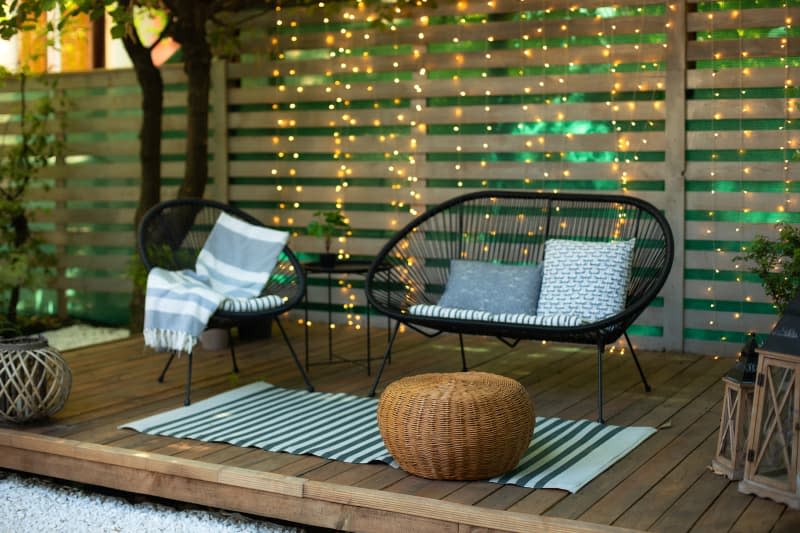3 Dos (and Don’ts!) for Staging Your Outdoor Spaces That’ll Make Your Home Sell Fast

When staging your house to sell, you might understandably be tempted to focus mainly on staging the interior spaces (like the living room) and either skimp on, or forego, zhuzhing up the exterior entirely with a little bit of paint. But today’s buyers are looking for outdoor spaces that can function as an extension of their homes — and a perfectly staged balcony, patio, deck, or backyard can help them envision themselves enjoying it.
I was curious to know how best to go about staging a home’s outdoor spaces, so I consulted Amanda Wiss, a home stager and the founder of Urban Staging in New York City. She offered these helpful dos and don’ts to keep in mind as you prepare to sell your home.
Do: Incorporate Rugs
Think rugs are only for indoors? Think again. Outdoor rugs come in a wide variety of colors, patterns, and materials, so no matter the aesthetic you’re going for (or the size of your outdoor space), you’ll be able to find one that helps tie the area together.
“These can be especially nice in a sprawling outdoor space, where a rug can make an outdoor couch and coffee table look cozy and intentional,” says Wiss.
And if your deck, patio, or balcony has seen better days, a rug can help cover up any imperfections — or, at the very least, keep buyers from fixating on them, she adds.
Do: Use Plants (Fake or Real)
This advice applies to outdoor spaces of all shapes and sizes: You can’t go wrong with adding a little greenery, Wiss says. Use real or fake plants, depending on your setup and budget.
“Investing in a little bit of landscaping work can go a long way in helping a buyer envision a nice, low-maintenance home,” she says. “An outdoor space overrun by weeds or, worse, completely barren, can look like a project, and not all buyers are willing to take that on. Staging is all about showing potential.”
Do: Be Specific
Help a prospective buyer envision exactly how they might use your home’s outdoor space. Al fresco dining with a few friends? An intimate lounge nook for sipping a glass of wine and stargazing? A place to host big parties?
Either way, as you think about staging your outdoor space, don’t try to make it all things for all people. Instead, be intentional — and choose your furniture and decor accordingly.
If you want to stage an outdoor seating area, limit yourself to a table, chairs, and maybe a grill. If you want to stage your outdoor space as a lounge, measure for a sofa or chairs that complement the space and facilitate conversation, says Wiss.
“You want to avoid a hodgepodge of furniture that will confuse the space,” she adds.
Don’t: Use Indoor Furniture/Decor
Yes, it’s just for staging and no one will actually be using the furniture and decor. But you should still use pieces that were made to withstand the elements. Otherwise, you might accidentally end up with soggy, moldy, rusty, hail-damaged, or otherwise unappealing furniture when buyers arrive for an open house.
The chances of your staging going through a couple of storms — whether that’s rain and hail in the summer or snow and ice in the winter — is high, so Wiss recommends not risking it.
Don’t: Overcrowd the Space
When it comes to staging, less is almost always more. (There’s a reason why home stagers ask you to remove all of your belongings, then bring in just a handful of carefully curated pieces.)
Be mindful to get rid of any clutter and keep decor to a minimum on patios, decks, balconies, and yards.
“Sometimes, empty space is better than trying to fit a makeshift dining and living room into an outdoor space,” says Wiss. “Don’t try to make this space more than it can handle.”
Don’t: Hang Lights
You might be tempted to hang twinkle lights to make your outdoor space seem dreamy and magical at night. But as Wiss wisely points out, most showings happen in broad daylight — so lights are just an unnecessary (and expensive) add-on.
“There are times when a heat lamp or other more stationary light could work but, for the most part, this will cut into your budget for no reason,” she says.

